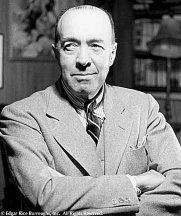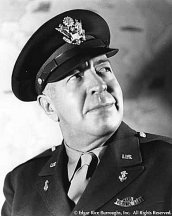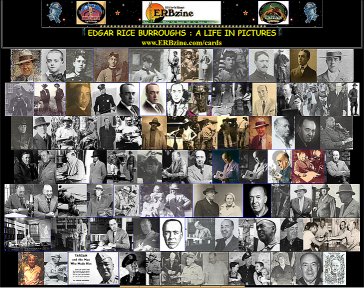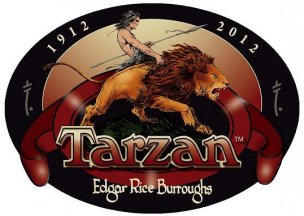Edgar
Rice Burroughs 1875 - 1950
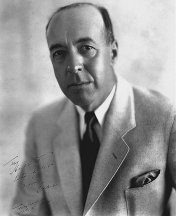 From
the day he was born, in Chicago, on September 1, 1975, until he submitted
half a novel to All-Story Magazine in 1911, Edgar Rice Burroughs failed
in almost everything he tried. He attended half a dozen public and private
schools before he finally graduated from Michigan Military Academy. Unable
to secure a commission in any military unit including the Chinese Army,
he enlisted in the Seventh U.S. Cavalry but at the time of his discharge
he was still a private. A succession of eighteen different jobs and business
ventures followed his marriage in 1900 to Emma Centennia Hulbert, but by
1911 he was pawning his watch to buy food for his family.
From
the day he was born, in Chicago, on September 1, 1975, until he submitted
half a novel to All-Story Magazine in 1911, Edgar Rice Burroughs failed
in almost everything he tried. He attended half a dozen public and private
schools before he finally graduated from Michigan Military Academy. Unable
to secure a commission in any military unit including the Chinese Army,
he enlisted in the Seventh U.S. Cavalry but at the time of his discharge
he was still a private. A succession of eighteen different jobs and business
ventures followed his marriage in 1900 to Emma Centennia Hulbert, but by
1911 he was pawning his watch to buy food for his family.
Having doodled and sketched and written poetry for amusement
most of his life, ERB decided to see if the public would be as receptive
to his imagination as were his friends and family. His first story, written
on the backs of old letterheads from bankrupt businesses, brought him $400.
Today, that story, A PRINCESS OF MARS, is acclaimed as the great
turning point of twentieth century science fiction.
A historical novel followed, but was rejected. Broke again,
he nearly quit. But a one-line letter from his publishers kept him going.
("For Mike's sake, don't give up!"). The next story would decide his future.
It was
TARZAN OF THE APES.
An astonishing success upon its appearance in All-Story
Magazine in 1912, TARZAN OF THE APES brought ERB a mere $700, but
after being rejected by practically every major book publisher in the country
it was finally printed in book form by A. C. McClurg & Company and
became 1914's best seller.
A torrent of novels followed: There were stories about
Venus, about Apaches, Westerns, social commentaries, detective stories,
tales of the Moon and the middle of the Earth -- and more and more TARZAN
books. By the time his pen was stilled, nearly 100 books bore ERB's name.
In 1918, TARZAN came to the screen. TARZAN OF THE APES,
starring Elmo Lincoln, was the first film in history to gross over a million
dollars. Since then, 39 TARZAN films have been produced, each of them a
great financial success. Although he liked to joke about it, ERB was bitterly
disappointed with the TARZAN pictures. Often, he would not even go to see
them. His TARZAN was a supremely intelligent, sensitive man. His
TARZAN sat in the House of lords when not other wise ranging through the
upper terraces of the African jungle. His TARZAN was the truly civilized
man, heroic, beautiful -- and above all, free. The world knows well
the semi-literate caricature that is Hollywood's TARZAN.
By 1919, with financial security assured, ERB moved to
California, where he purchased the 550 acre estate of General Harrison
Gray Otis, renaming it "Tarzana Ranch." Here, he wrote prodigiously, managed
the world-wide enterprise that is now Edgar Rice Burroughs, Inc. and devoted
his leisure time to his family and to his beloved ranch.
ERB is remembered as a modest man who never took himself
or anything else too seriously. His friends recall his ready sense of humor,
his great love of the outdoors and his unbounded pride in his country,
which he served at every opportunity.
In 1941 he volunteered to become America's oldest war
correspondent, and returned home from the South Pacific only after suffering
a series of heart attacks. Ironically, he was unable to find a home in
TARZANA. Instead, he spent his remaining years as a semi-invalid in a modest
house on Zelzah Avenue in Encino. It was there, on March 19, 1950 that
Edgar Rice Burroughs set down his pen for the last time. His ashes were
carried home to TARZANA, where, according to his own wish, they repose
in an unmarked grave.
It may be that ERB made his final commentary on a long
and meaningful life when he wrote the very last TARZAN story: The last
line was . . .
"Thank God for everything."
~ Edgar Rice Burroughs, Inc.
BIOGRAPHY 2
Tarzan was born in the jungles of Africa, but his creator
first saw the light of day amidst more tranquil surroundings.
Edgar Rice Burroughs was born in Chicago on September
1st, 1875. His father, George Tyler Burroughs, was a Civil War veteran
and now a successful businessman. Major Burroughs and his wife Mary had
five other boys besides Edgar, but two of the children died in infancy,
leaving Edgar the youngest of the family.
"Eddie" attended several schools during his formative
years, often being shuttled from one to another due to the outbreak of
various diseases. At this time it was standard to learn Greek and Latin
in addition to English composition, and Burroughs would often lament his
erratic schooling, which resulted in his (or so he said) learning little
English while taking the same Greek and Latin courses over and over again.
Despite his claims to the contrary, this early exposure to Classical literature
and mythology would serve Burroughs well in his future writing career.
An influenza epidemic hit Chicago in 1891; hundreds died,
and Edgar's worried parents wondered how they could protect their fifteen-year-old
son. A few years earlier two of Edgar's brothers, George and Harry, had
started a cattle ranch out west in Idaho. This seemed like a logical safe
haven, so George and Mary packed Edgar onto an Idaho-bound train.
Ed took to the frontier life like a duck to water. He
rode the range, herded cattle, busted a bucking broncho, and got to know
a few thieves, murderers and bad men. Idaho at this time was still a pretty
rough-and-tumble place; a range war was brewing between cattle ranchers
and sheepmen, the law was fairly lax, and there were even shootouts at
the local saloon. Young Ed loved the half year he spent in Idaho ~ then
his parents found out about these sordid events of frontier life and sent
Ed off to the Phillips Academy in Andover, Massachusetts.
But Ed wound up being a bit too rough-and-tumble himself
for the faculty at Andover, so the Major shipped his son off to the Michigan
Military Academy at Orchard Lake. Here Ed's frontier skills stood him in
good stead; he became an excellent trick rider and crack shot, and even
did fairly well in his studies. Not that he was an angel during his stay
at MMI (he tried deserting during his first year, among other escapades)
but Burroughs had apparently found an atmosphere conducive to his spirit.
Burroughs graduated from the Michigan Military Academy
in 1895 but, not really knowing what to do with his life, accepted the
Academy's offer of an instructorship. (He had tried for an appointment
to the West Point Military Academy but failed the entrance exam.) Hankering
to see some action, Ed quit his position with the Academy early the next
year and signed up with the U.S. Army as a buck private in the hopes of
eventually becoming an officer. Being a natural horseman Ed got his wish
and was assigned to the Seventh United States Cavalry (General Custer's
old regiment) stationed at Fort Grant, Arizona Territory.
Burroughs would define this as a time where he "chased
Apaches, but never caught up with them." The best he succeeded in catching
was dysentery. The work was far from glamorous, mainly digging ditches
and repairing the rickety fort. Burroughs went out on patrols but the few
Apache renegades still roaming free proved quite elusive. To compound matters,
during a routine medical exam the post doctor determined that Burroughs
had a heart murmur ~ and thus ineligible to be promoted to the officer
class. With an army career now out of the question, Ed received his discharge
in early 1897.
Ed made another go of it in Idaho, punching cows for his
brothers and others, even running a dry goods store for a time. This rather
freeform life couldn't last forever, so in 1899 it was back to Chicago
and work at his father's American Battery Company. With a steady paycheck
he decided to marry his childhood sweetheart, Emma Centennia Hulbert, in
1900. But a regular routine apparently wasn't what Ed wanted, so in 1904
he and Emma struck out again for Idaho.
The next several years would be a frustrating search by
Ed for his place in life. His brothers George and Harry had given up cattle
ranching for gold dredging, but this program fizzled shortly after Ed arrived.
He got a job as a railway policeman in Salt Lake City but gave up after
awhile and took Emma back to Chicago. Among his many short-live jobs were
door-to-door salesman, an accountant, the manager for the clerical department
of Sears, Roebuck & Company, peddler for a quack alcoholism cure and,
finally, a pencil sharpener wholesaler. By this point (1911) Burroughs
had two children (Joan and Hulbert), was flat broke, and was left with
only one way out of this cycle: he could dream.
So the story goes, Edgar Rice Burroughs was sitting in
his rented office and waiting for his crack pencil sharpener salesmen to
report in, supposedly their pockets bulging with orders. Besides waiting,
one of Burroughs' duties was to verify the placement of advertisements
for his sharpeners in various magazines. These were all-fiction "pulp"
magazines, a prime source of escapist reading material for the rapidly
expanding middle class. Verifying the pencil sharpener ads didn't exactly
take much time. The pencil sharpener salesmen never showed up, so Burroughs
spent his idle time reading those pulp magazines. And an idea was born.
After reading several thousand words of breathless pulp
fiction Burroughs determined ~ or so he claimed ~ that "if people were
paid for writing rot such as I read in some of those magazines that I could
write stories just as rotten. As a matter of fact, although I had never
written a story, I knew absolutely that I could write stories just as entertaining
and probably a whole lot more so than any I chanced to read in those magazines."
This may be nothing more than a legend Burroughs liked to tell to show
how he came into his own as a writer. He had actually written stories before
this time, mostly fairy tales and poems he created for his children, nieces
and nephews. The most elaborate of these stories, Minidoka, 937th Earl
of One Mile Series M, has been printed by Dark Horse Comics.
But in 1911, Burroughs decided to write a full-blown novel,
and the tale he wrote was as far removed from the life of a pencil sharpener
wholesaler as one could possibly imagine. This flight of fancy, entitled
"Dejah Thoris, Martian Princess," was so exotic that Burroughs was worried
that editors might think he was a little touched in the head. So he submitted
the story under a pseudonym, Normal Bean, a joke indicating that his head
was indeed screwed on the right way.
In submitting his manuscript to All-Story magazine he
found luck the first time out: editor Thomas Metcalf liked the tale and
offered Burroughs 400 dollars, an extravagant sum. The story, renamed "Under
the Moons of Mars," was serialized from February to July of 1912. Burroughs
wound up being renamed as well: his pseudonym was changed to Norman Bean.
(When this story appeared in book form it received its final title, A Princess
of Mars; both Normal and Norman were abandoned in favor of the author's
real name.) By the time of the last installment of "Under the Moons of
Mars" Burroughs had completed his third novel. The second one, "The Outlaw
of Torn," was rejected by Metcalf, but the third novel was a little trifle
called "Tarzan of the Apes." Burroughs was now a bona fide full-time writer.
"Tarzan of the Apes" appeared in the October 1912 issue
of All-Story magazine. Burroughs received 700 dollars for the tale ~ and
his career was off and running. Burroughs quickly discovered (probably
to his secret delight, and certainly to the delight of countless readers)
that he had many more tales to tell. There would be the inevitable Tarzan
and Mars sequels but Burroughs' imagination needed even more worlds in
which to roam, and so in the next few years he would try his hand at almost
every type of story imaginable. Burroughs created the fabulous prehistoric
inner world of Pellucidar (starting with At the Earth's Core), wrote other
cave man fantasies (The Eternal Savage and The Land That Time Forgot),
tales of courtly intrigue (The Mad King), a horror story (The Monster Men),
novels of social realism (The Girl From Hollywood), Robinson Crusoe-type
adventures (The Cave Girl), and one story that combined all of the above
(The Mucker). Later still he would write westerns (The War Chief and others)
and created yet another series, this one set on the planet Venus (starting
with Pirates of Venus). But Tarzan would earn Burroughs his greatest success.
A second son and third child of the Burroughses, John
Coleman, was born in 1913, and the following year saw a birth of a different
sort: Tarzan of the Apes was published as a book. This novel is still in
print today. The first Tarzan movie appeared in 1918, with Elmo Lincoln
in the title role, which only helped to make Tarzan and Burroughs even
more popular. Eventually Burroughs would put out a total of 26 Tarzan books,
and left a fragment of another that was only discovered long after his
death. Most of Burroughs' other stories would also appear in book form,
and are available in libraries and bookstores worldwide.
By 1916 Burroughs felt that he had earned a vacation,
and so he packed up Emma and the children (and their dog Tarzan) and set
out on a cross-country camping trip. At this time there was no such thing
as an interstate highway system ~ actually, there were very few roads at
all. Heading out with a touring car, a truck and a trailer the party set
off for Maine but eventually wound up in Southern California. Eventually
the expedition made the return trip to Chicago, but the California bug
had bitten Burroughs. In 1919, thanks to the success of Tarzan, Burroughs
was able to purchase a large ranch north of Los Angeles. He named it Tarzana.
As the Lord of Tarzana, Burroughs had seemingly found
the good life. Tarzan had provided him with a comfortable living, his books
were selling worldwide (even in the Soviet Union, where such tales were
not well regarded by the Communist government), and the nearby community
of Hollywood was busy cranking out Tarzan movies. (Tinsel Town even provided
Burroughs with a son-in-law: Jim Pierce, who starred in "Tarzan and the
Golden Lion," married Joan Burroughs in 1928.) The ultimate compliment
was paid by the citizens of the community that had sprung up around the
Tarzana ranch: they voted to adopt the name "Tarzana" when their town was
incorporated in 1928.
Burroughs liked to think of himself as a hard-headed businessman
and concluded that he could make an even better living if he founded his
own company. And so in 1923 Burroughs became an employee of Edgar Rice
Burroughs, Inc. This was an unusual step for an author to take, although
it is now quite common. Burroughs would even start publishing his own books,
beginning in 1931 with Tarzan the Invincible. The last book to appear under
the Edgar Rice Burroughs, Inc. imprint was I Am a Barbarian in 1967.
The year 1932 was ushered in with a scream, as MGM released
the first sound Tarzan movie, "Tarzan the Ape Man" with the now legendary
Johnny Weissmuller. Hollywood did not show a great deal of fidelity to
Burroughs' original story this time around, but the movie's success meant
that the Tarzan books were selling better than ever. But financial success
was overshadowed by the problems in Burroughs' personal life, as he and
Emma divorced in 1934. He married Florence Dearholt the following year
and in 1940, with war raging in Europe, the couple decided to head further
west to Hawaii.
Even though he was entering the last decade of his life
Burroughs continued to be physically active, and still wrote stories for
the pulp magazines and his own company. Hulbert Burroughs came out to Hawaii
to visit his father in late 1941, and on the morning of December 7th, as
the two played tennis, the Japanese bombed nearby Pearl Harbor. Thus began
the last adventure of Edgar Rice Burroughs' life.
Edgar Rice Burroughs was too old to see active service
in World War II ~ he was 66 at the time of the Pearl Harbor attack ~ but
as an established writer he served the war effort by becoming a war correspondent.
He was the oldest war correspondent to serve in the Pacific theater, flying
from island to island (even bumping into his son Hulbert, who was serving
as a war photographer), reporting on troop activities, even going out on
bombing runs with the 7th Air Force. Burroughs came through this period
of life unscathed, although he would send Tarzan out on a more danger-filled
mission in Tarzan and the "Foreign Legion" (1944).
With the war's end Burroughs returned to California and
settled into a small home near Tarzana. He and Florence had divorced in
1942, so Ed devoted his final years to his children. He died on March 19,
1950. His writings and characters had entertained three generations of
readers and moviegoers. In the 1960s, thanks to a paperback boom, a new
generation discovered the writings of Edgar Rice Burroughs. And now, at
the beginning of a new millennium, another generation has rediscovered
Burroughs through Disney's animated classic "Tarzan."
The works of Edgar Rice Burroughs will endure as classic
tales of adventure, romance and wonder. Tarzan remains one of the best-known
literary characters in the entire world. But there is more to Burroughs
than just Tarzan. Take a look around the rest of our website ~ we're sure
you'll discover some surprises here or there! If you wish to learn more
about Burroughs, the best source remains Irwin Porges' 1975 biography Edgar
Rice Burroughs: The Man Who Created Tarzan. While the book is out of print
you can still find it in libraries and through used book dealers.
BIOGRAPHY 3
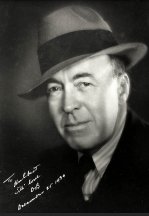 EDGAR
RICE BURROUGHS (September 1, 1875 - March 19, 1950), was born in Chicago,
fifth of six sons of businessman George Tyler Burroughs and Mary Evaline
(Zieger) Burroughs. He was the youngest of four surviving brothers and
attended Chicago's Brown elementary. By 1886 he rode horseback to the Harvard
School at 18th and Indiana Avenue. He was taught Greek and Latin before
learning English composition.
EDGAR
RICE BURROUGHS (September 1, 1875 - March 19, 1950), was born in Chicago,
fifth of six sons of businessman George Tyler Burroughs and Mary Evaline
(Zieger) Burroughs. He was the youngest of four surviving brothers and
attended Chicago's Brown elementary. By 1886 he rode horseback to the Harvard
School at 18th and Indiana Avenue. He was taught Greek and Latin before
learning English composition.
An influenza epidemic in 1891 Chicago caused ERB's parents
to send him to Idaho where older brothers Harry and George, with partner
Lew Sweetser, owned the Bar Y Ranch in Cassia County. The city boy loved
horses and became an expert bronco buster.
That Fall he was sent to Phillips Academy at Andover,
Massachusetts. Popular, ERB was elected class president but disliked the
formal curriculum and ran away. ERB's father, a Union cavalry officer during
the American Civil War, believed a military school might benefit his son.
At Michigan Military Academy, Orchard Lake (Fall 1892), ERB's commandant
was Captain Charles King, a name he later used in his novels. ERB was on
the football and cavalry teams and was editor-in-chief and artist for the
student newspaper The Adjutant. He remained at Michigan Military Academy
after graduating in 1896 as Assistant Commandant; a Professor of Geology,
Cavalry and Gatling Gun.
ERB desired entry to West Point but failed the entrance
exam (14 of 118 applicants were accepted). He enlisted in the army and
was assigned duty at Fort Grant, Arizona, "B" Troop, 7th Cavalry, under
the command of Colonel "Bull" Sumner. ERB's duties were "digging boulevards
in the desert where no boulevards were needed" and chasing Indian outlaws
without strategy or success. A bout of dysentery uncovered a heart murmur
which disqualified him for an army commission. ERB obtained an honorable
discharge and returned to his brothers' cattle ranch in Idaho.
Ever desirous to start his own business, he bought a stationery
store in Pocatello (1898). He sold it back to the original owner at year's
end. Back at his brothers' ranch he decided the cattle business was not
for him. In 1898 ERB returned to Chicago to work at his father's American
Battery Company.
A regular salary ($15/week) encouraged ERB to marry childhood
sweetheart Emma Centennia Hulbert on January 31, 1900. Her father, Alvin
Hulbert, was proprietor of the Sherman and Great Northern hotels. In 1903,
ERB and Emma joined brother George in Idaho to operate a gold dredge in
the Stanley Basin.
ERB later joined brother Harry's gold dredging operations
near Parma, Idaho (1904) in which town he was popular enough to be elected
alderman; but the gold business soon failed. ERB and Emma moved to Salt
Lake City, Utah where he worked as a railroad policeman rousting hoboes
and drunks from freight cars. Dissatisfied, the couple sold their belongings
at auction and returned to Chicago.
From 1904 to 1908 temporary jobs included time-keeper,
light bulb and candy sales, peddling Stoddard's lectures, E. S. Winslow
Company accountant and, at emotional nadir, volunteering to officer in
the Chinese army (never happened). Early in 1908 he landed an excellent
job managing the clerical department at Sears, Roebuck & Company but
felt his destiny lay elsewhere. He resigned August 1908, determined to
go into business for himself.
A bleak period followed. Emma's jewelry was pawned to
buy food. They lived in Oak Park when Joan was born January 1908. Hulbert,
their first son, arrived August 1909, by which time ERB was office manager
for Physicians Co-Operative Association. The company sold "Alcola," an
alleged cure for alcoholism but the Food and Drug Administration shut them
down within a year.
Alcola's president, Dr. Stace, and ERB formed the Stace-Burroughs
Company which sold booklets (written by ERB) on expert salesmanship. The
Stace-Burroughs Company sank without a trace.
ERB formed a new agency which sold pencil sharpeners.
While agents peddled product door to door he sat in a borrowed office.
Killing time, ERB checked his ads running in various pulp magazines. He
read some of the fiction and decided "if people are paid for writing such
rot, I can write something just as rotten."
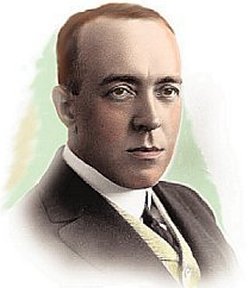 He
began his first story early in 1911. It was influenced by the popular theories
of astronomer Percival Lowell. The story was so improbable he signed it
"Normal Bean" to signify he was not insane. ERB sent it to Thomas Newell
Metcalf, editor of All-Story, where it was accepted immediately. Metcalf
changed the title to "Under the Moons of Mars" and ran it in six installments
February to July 1912. A copy editor, assuming an error, changed ERB's
nom de plume to Norman Bean. The pun spoiled, ERB dropped the alias permanently.
He received $400 for his story, a staggering sum at the time.
He
began his first story early in 1911. It was influenced by the popular theories
of astronomer Percival Lowell. The story was so improbable he signed it
"Normal Bean" to signify he was not insane. ERB sent it to Thomas Newell
Metcalf, editor of All-Story, where it was accepted immediately. Metcalf
changed the title to "Under the Moons of Mars" and ran it in six installments
February to July 1912. A copy editor, assuming an error, changed ERB's
nom de plume to Norman Bean. The pun spoiled, ERB dropped the alias permanently.
He received $400 for his story, a staggering sum at the time.
Metcalf sensed untapped potential and suggested ERB write
a story along the lines of Arthurian legend. ERB obliged with a Gothic
romance entitled "The Outlaw of Torn." All-Story rejected it (eventually
sold to Street & Smith's New Story Magazine in 1914). He had
begun a third story "Tarzan of the Apes" in December 1911 and finished
May 1912. Metcalf published it complete in one issue of All-Story, October
1912. ERB received $700, resulting in a decision to take up writing full
time. This decision was further strengthened by the birth of a third child,
John Coleman Burroughs (February 28, 1913), who would eventually illustrate
twelve of his father's first editions.
During the next twelve months ERB wrote and sold eight
novels.
After many rejection slips from several major publishing
houses, ERB received an offer from A.C. McClurg & Company, Chicago.
The company had previously rejected "Tarzan of the Apes" but the story's
popularity resulted in a signed contract. ERB's first book "Tarzan of the
Apes" was published June 17, 1914. It became a national best seller. McClurg
published a total of 29 ERB books between 1914-1929. Most of these first
editions were illustrated by J. Allen St. John, a Chicago artist now identified
with the Burroughs legend.
In 1919, ERB purchased a 540-acre ranch in California's
San Fernando Valley. Idyllic, ERB played at gentleman farming while solidifying
a multi-million dollar industry. The ranch was named "Tarzana" and the
city which sprang up around him officially took the name on December 11,
1930.
ERB routinely sold first serial rights to the pulps while
retaining reprint and book rights. He was 36 when his first story was published
in 1912. Eleven years later ERB incorporated himself and by 1931 decided
to publish his own books to maximize earnings. ERB succeeded admirably
and ERB, Inc. published 24 first editions.
In 1934, their children grown, ERB and Emma's divorce
became final December 6, 1934. Four months later on April 4, 1935 he married
Florence (Gilbert) Dearholt, a former actress and divorcee with two small
children. They had a prenuptial agreement to part as friends if the marriage
failed. They divorced after seven years on May 4, 1942. ERB remained devoted
to her children the rest of his life.
ERB and son Hulbert witnessed the Japanese attack on Pearl
Harbor (December 7, 1941). A one-time major in the Illinois State Militia
at Oak Park in 1919, ERB was finally in the right place at the right time
to be of service. He became the oldest WWII war correspondent. His "Laugh
It Off" column was published regularly in the Honolulu Advertiser. He visited
Australia and several Pacific atolls and went on combat bombing missions
with the 7th Air Force out of Kwajalein.
After the war, ERB retired to a modest home in Encino,
California. He died on March 19, 1950 of a heart attack induced by a form
of Parkinson's disease. His ashes were buried beneath a black walnut tree
in the front yard of his corporate headquarters on Ventura Boulevard.
In the last year of his life ERB reread all of his books
"to see what I had said and how I'd said it."
George T. McWhorter
ERB Memorial Collection ~ University
of Louisville

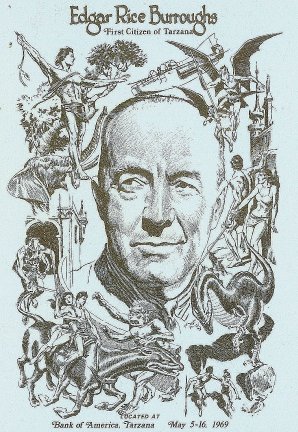
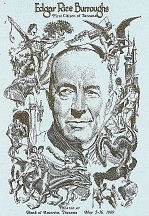
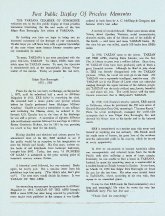
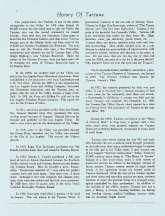
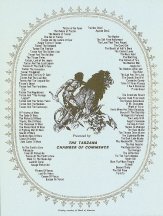
 From
the day he was born, in Chicago, on September 1, 1975, until he submitted
half a novel to All-Story Magazine in 1911, Edgar Rice Burroughs failed
in almost everything he tried. He attended half a dozen public and private
schools before he finally graduated from Michigan Military Academy. Unable
to secure a commission in any military unit including the Chinese Army,
he enlisted in the Seventh U.S. Cavalry but at the time of his discharge
he was still a private. A succession of eighteen different jobs and business
ventures followed his marriage in 1900 to Emma Centennia Hulbert, but by
1911 he was pawning his watch to buy food for his family.
From
the day he was born, in Chicago, on September 1, 1975, until he submitted
half a novel to All-Story Magazine in 1911, Edgar Rice Burroughs failed
in almost everything he tried. He attended half a dozen public and private
schools before he finally graduated from Michigan Military Academy. Unable
to secure a commission in any military unit including the Chinese Army,
he enlisted in the Seventh U.S. Cavalry but at the time of his discharge
he was still a private. A succession of eighteen different jobs and business
ventures followed his marriage in 1900 to Emma Centennia Hulbert, but by
1911 he was pawning his watch to buy food for his family.
 EDGAR
RICE BURROUGHS (September 1, 1875 - March 19, 1950), was born in Chicago,
fifth of six sons of businessman George Tyler Burroughs and Mary Evaline
(Zieger) Burroughs. He was the youngest of four surviving brothers and
attended Chicago's Brown elementary. By 1886 he rode horseback to the Harvard
School at 18th and Indiana Avenue. He was taught Greek and Latin before
learning English composition.
EDGAR
RICE BURROUGHS (September 1, 1875 - March 19, 1950), was born in Chicago,
fifth of six sons of businessman George Tyler Burroughs and Mary Evaline
(Zieger) Burroughs. He was the youngest of four surviving brothers and
attended Chicago's Brown elementary. By 1886 he rode horseback to the Harvard
School at 18th and Indiana Avenue. He was taught Greek and Latin before
learning English composition.

